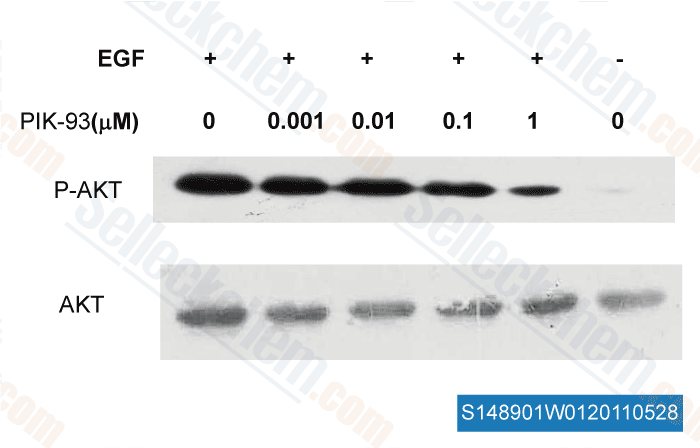|
Toll Free: (877) 796-6397 -- USA and Canada only -- |
Fax: +1-832-582-8590 Orders: +1-832-582-8158 |
Tech Support: +1-832-582-8158 Ext:3 Please provide your Order Number in the email. |
Technical Data
| Formula | C14H16ClN3O4S2 |
||||||||||
| Molecular Weight | 389.88 | CAS No. | 593960-11-3 | ||||||||
| Solubility (25°C)* | In vitro | DMSO | 78 mg/mL (200.06 mM) | ||||||||
| Ethanol | 1 mg/mL (2.56 mM) | ||||||||||
| Water | Insoluble | ||||||||||
| In vivo (Add solvents to the product individually and in order) |
|
||||||||||
|
* <1 mg/ml means slightly soluble or insoluble. * Please note that Selleck tests the solubility of all compounds in-house, and the actual solubility may differ slightly from published values. This is normal and is due to slight batch-to-batch variations. * Room temperature shipping (Stability testing shows this product can be shipped without any cooling measures.) |
|||||||||||
Preparing Stock Solutions
Biological Activity
| Description | PIK-93 is the first potent, synthetic PI4K (PI4KIIIβ) inhibitor with IC50 of 19 nM; this compound is shown to inhibit PI3Kα with IC50 of 39 nM. | |||||||||||
|---|---|---|---|---|---|---|---|---|---|---|---|---|
| Targets |
|
|||||||||||
| In vitro | PIK-93 inhibits PI3Kγ and PI4KIIIβ, with IC50 values of 16 nM and 19 nM, respectively. This compound also inhibits other members of PI3Ks, including PI3Kα, β, and δ, with IC50 values of 39 nM, 0.59 μM, and 0.12 μM, respectively. It shows no obvious inhibitory effect against a panel of other kinases, even at a concentration of 10 μM. [1] In differentiated HL60 (dHL60) cells, this compound (0.5 μM–1 μM) impairs consolidation and stability of the leading edge formed after treatment with uniform f-Met-Leu-Phe (fMLP). It alters the localization, but not the amount, of the fMLP-dependent accumulation of total F-actin. In fMLP gradients, this chemical reduces the chemotactic index and triples the cells' turning frequency. [2] In COS-7 cells, this compound (250 nM) effectively abrogates the accumulation of CERT-PH domain and FL-Cer in Golgi. It of the same concentration also significantly inhibits the conversion of [3H]serine-labeled endogenous ceramide to sphingomyelin. These facts indicate a key role of PI4KIIIβ in ceramide transport between the ER and Golgi, as well as in the regulation of spingomyelin synthesis. [3] In T6.11 cells, this compound (300 nM) reduces carbachol-induced translocation of TRPC6 to the plasma membrane and net Ca2+ entry. [4] A recent report shows that this chemical has anti-enterovirus effects, as revealed by its inhibition of both poliovirus (PV) and hepatitis C virus (HCV) replication, with EC50 values of 0.14 µM and 1.9 µM, respectively. [5] | |||||||||||
| Features | A novel and potent inhibitor of both PI3Kγ and PI4KIIIβ. |
Protocol (from reference)
| Kinase Assay:[1] |
|
|---|---|
| Cell Assay:[2] |
|
References
|
Customer Product Validation

-
, , Dr. Zhang of Tianjin Medical University
Selleck's PIK-93 Has Been Cited by 13 Publications
| Oncogenic RAS induces a distinctive form of non-canonical autophagy mediated by the P38-ULK1-PI4KB axis [ Cell Res, 2025, 10.1038/s41422-025-01085-9] | PubMed: 40055523 |
| Synaptic vesicle fusion promotes phosphatidylinositol 4-phosphate synthesis for efficient synaptic transmission [ Cell Rep, 2025, 44(5):115634] | PubMed: 40299749 |
| Golgi retention and oncogenic KIT signaling via PLCγ2-PKD2-PI4KIIIβ activation in gastrointestinal stromal tumor cells [ Cell Rep, 2023, 42(9):113035] | PubMed: 37616163 |
| Phenotypic Screening for Small Molecules that Protect β-Cells from Glucolipotoxicity [ ACS Chem Biol, 2022, 10.1021/acschembio.2c00052] | PubMed: 35439415 |
| ACBD3 modulates KDEL receptor interaction with PKA for its trafficking via tubulovesicular carrier [ BMC Biol, 2021, 19(1):194] | PubMed: 34493279 |
| The carboxy terminal coiled-coil modulates Orai1 internalization during meiosis [ Sci Rep, 2021, 11(1):2290] | PubMed: 33504898 |
| The carboxy terminal coiled-coil modulates Orai1 internalization during meiosis [ Sci Rep, 2021, 11(1):2290] | PubMed: 33504898 |
| Regulation of Anion Channel LRRC8 Volume-Regulated Anion Channels in Transport of 2'3'-Cyclic GMP-AMP and Cisplatin under Steady State and Inflammation [ J Immunol, 2021, 206(9):2061-2074] | PubMed: 33827893 |
| Escherichia coli as a platform for the study of phosphoinositide biology. [ Sci Adv, 2019, 5(3):eaat4872] | PubMed: 30944849 |
| A Single Point Mutation in the Rhinovirus 2B Protein Reduces the Requirement for Phosphatidylinositol 4-Kinase Class III Beta in Viral Replication [ J Virol, 2018, 92(23)e01462-18] | PubMed: 30209171 |
RETURN POLICY
Selleck Chemical’s Unconditional Return Policy ensures a smooth online shopping experience for our customers. If you are in any way unsatisfied with your purchase, you may return any item(s) within 7 days of receiving it. In the event of product quality issues, either protocol related or product related problems, you may return any item(s) within 365 days from the original purchase date. Please follow the instructions below when returning products.
SHIPPING AND STORAGE
Selleck products are transported at room temperature. If you receive the product at room temperature, please rest assured, the Selleck Quality Inspection Department has conducted experiments to verify that the normal temperature placement of one month will not affect the biological activity of powder products. After collecting, please store the product according to the requirements described in the datasheet. Most Selleck products are stable under the recommended conditions.
NOT FOR HUMAN, VETERINARY DIAGNOSTIC OR THERAPEUTIC USE.
